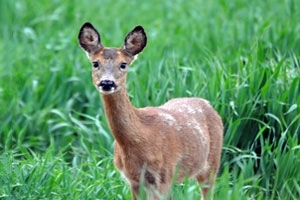Roe deer (Capreolus capreolus)
 We regularly hear nowadays about the dreadful declines in our British wildlife and how in the past everything was so much rosier, with our woods and fields teeming with flora and fauna. Well, of course much of what is said is true, but actually some species are faring much better now than they did a few hundred years ago!
We regularly hear nowadays about the dreadful declines in our British wildlife and how in the past everything was so much rosier, with our woods and fields teeming with flora and fauna. Well, of course much of what is said is true, but actually some species are faring much better now than they did a few hundred years ago!
Take the roe deer, for instance. Back in the 1700s the roe deer was basically hunted to extinction in England, so that by the beginning of the 1800s it was only found in wooded areas of Scotland. The Victorians started to re-introduce them back into the English countryside and coupled with a natural spread back south, roe deer can now be commonly found, with just a few small exceptions, across the whole of England and Wales once more.
The months of July and August are the mating season or rut for roe deer, where bucks will become aggressive and often have fierce fights with other males to gain or maintain a territory. Because the females or “does” will wander from territory to territory, bucks will often mate with several does, helping to spread the genes of these dominant males. What is fascinating, however, is that the female’s pregnancy, which lasts for ten months, with the kids being born in May and June the following year, is not quite what you might expect.
Once the eggs are fertilised by the buck’s sperm, they travel to the uterus but remain unattached, simply spending the next five months floating within the womb. During this time the embryo hardly grows at all so that by the end of the year it is little more than 0.3mm long. This is called “delayed implantation” and also occurs in a number of other animals such as badgers, grey seals and most bats.
Around the end of the year, the embryo is genetically programmed to send a message to the mother based on a protein that is only found in roe deer. She immediately reacts by releasing quantities of hormones to allow the embryo to start growing rapidly, and before long it attaches itself the wall of the uterus, linking also with the placenta, thereby creating a “normal” pregnancy.
So what if any, are the benefits of delayed implantation? Well, at the time of mating there is an abundance of food and does are in peak condition, resulting in them being extremely fertile. Food remains plentiful throughout the autumn and early winter and the pregnant females, with virtually no demands from the embryos that they are carrying, make the most of this to ensure that they have adequate body reserves to see them through the long winter.
Roe deer usually give birth to twins, sometimes triplets, and so the demands on the doe would be great indeed if she had to sustain these throughout the pregnancy. Instead, once the rapidly growing young start to put real demands on their mother, spring growth has sprung into life and the doe once again has a good food supply. When the kids are born towards the end of May and into June, the weather is kind and the vegetation is high, creating plenty of cover for the newly born kids to hide away from the prying eyes of predators.
So, given a second chance by us, wildlife can often bounce back and are well equipped and prepared to do just that. If you see a roe doe this autumn, remember that she already has plans for next year!
Peter Thompson
Advisory

Download Peter Thompson's essential 26-page book, featuring beautiful photography and detailed profiles of Britain's wildlife
Download FREE >